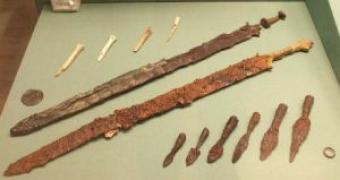Iron production was the most sophisticated form of metalworking for ancient civilizations.
The complicated technology of the iron ore reduction has its roots in ancient Anatolia (today Turkey) in the Hittite and Mitanni kingdoms, 4,000 years ago. There is evidence that in northern India, it appeared 3,800 years ago.
Independently, iron was produced in Sub-Saharan Africa, in today's Nigeria, at the same time.
Amongst the oldest iron objects discovered so far, there are a pearl of meteoric iron found in an Egyptian tomb, 5,200 years old; and a knife blade of terrestrial iron found in the Khufu's pyramid.
The new metal was rare during that period as the Hittite and Mitanni kings kept the secret of its fabrication, controlling the traded amounts, conscious of the power and value of this metal.
From the letter of a pharaoh, 3,400 years old, addressed to a Hittite king, emerges the fact he was asking for iron. The king gave him ? a dagger!
3,500 years ago, the metal was produced in larger amounts, as amongst the lists of tributes received by Thutmose the Third there is also the new metal.
Iron is one of the most frequent metals in the terrestrial crust.
At the beginning, it was achieved by heating the ore, placed alternatively with charcoal. But the temperatures achieved during those times were not enough to melt the iron and it resulted only a spongy mass which had to be cleaned of dross and hammered.
As it could not be molten, the iron was shaped by hammer. This technique required bellows. Before the bellows, there were the fan and blowing tube.
Stones or metal clods were employed as hammer and anvil and a kind of rough metal pincers were used for grabbing. This primitive technique produced from plows and weapons to jewelry.
Later, more advanced techniques employed complicated furnaces, dosing the carbon oxide from inside the furnace for getting soft iron. The melting point was relatively low, 1180-1215o C. To neutralize the silicon lime was used.
About 3,200 years ago, the new metal spread rapidly throughout Europe (through the Balkans), western Asia and Far East. The beginning of the Iron Age corresponds to a peak of the Bronze Age.
But starting with the fifth century BC, the iron comes to be frequently used in Europe, where most tools were made of this material. In Africa, iron gave to Bantu tribes a technological superiority that enabled them to colonize almost half of Black Africa, replacing the Stone Age level Bushmen and Pygmy populations. The pre-Columbian civilizations in the Americas never discovered the iron.

 14 DAY TRIAL //
14 DAY TRIAL //